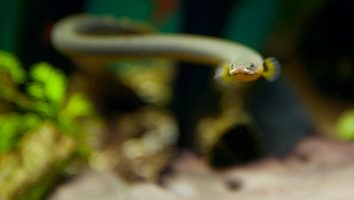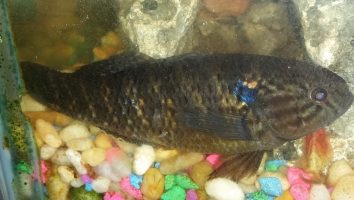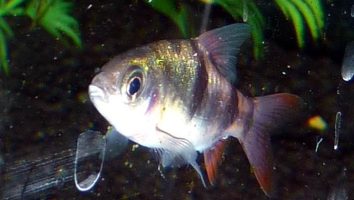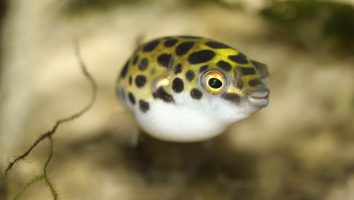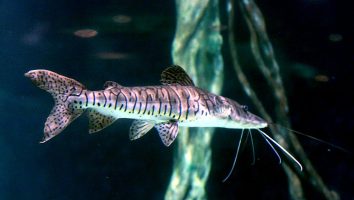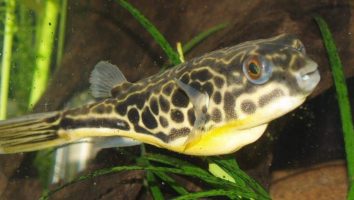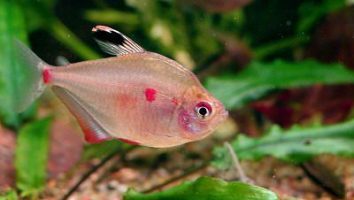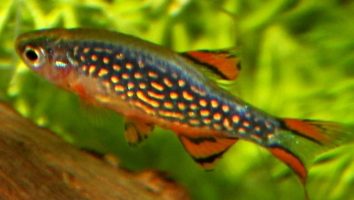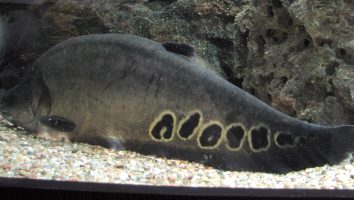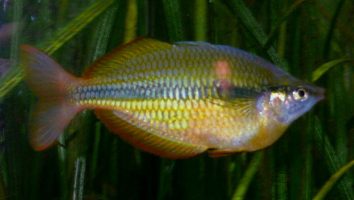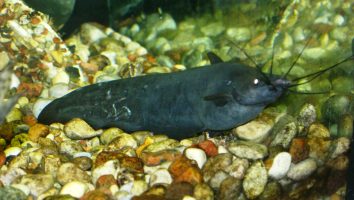The even-spotted squeaker is a beautiful freshwater fish that is relatively easy to care for.
This guide will teach you everything you need to know about even-spotted squeaker care. You’ll learn about their diet, size, lifespan, and more!
Table of contents
Species overview
The even-spotted squeaker (Synodontis nigriventris) is a type of African catfish that’s found throughout a large portion of the central and western regions of the continent.
These fish prefer to live in deep, murky waters where there is very little light. This is likely due to the fact that their eyesight isn’t very good. Because of this, they use their barbels ( whisker-like appendages) to help them find food in the dark.
Even-spotted squeakers are omnivores, which means they will eat both plants and animals. In the wild, their diet consists mostly of insects, small crustaceans, and mollusks.
This is a popular fish for aquariums because it is relatively peaceful and can be compatible with a wide variety of tank mates.
Appearance
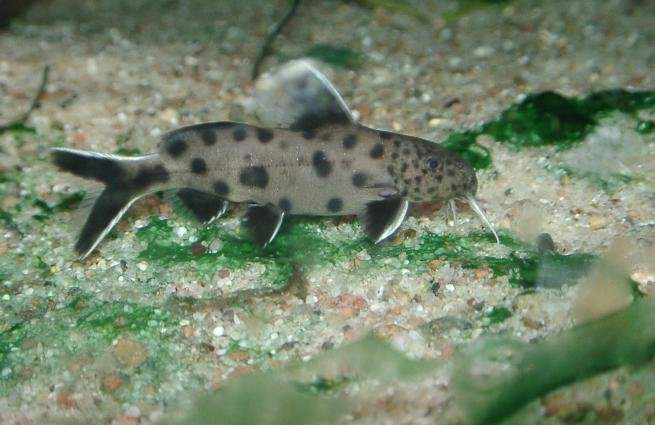
The Even-Spotted Squeaker is a unique-looking fish that is sure to turn heads. As their name suggests, this fish is covered in spots that are evenly distributed across their body.
The base color of this fish is a light brown that can sometimes look a bit yellowish. The spots are a dark brown and they’re relatively large compared to the size of the fish.
These spots are not only on the body of the fish but on their fins as well. The dorsal and anal fins are both covered in spots and their caudal fin has a few as well.
The Even-Spotted Squeaker has a long and thin body that is very hydrodynamic. This helps them swim quite fast in short bursts.
Their fins are all relatively standard in size and shape. The dorsal and anal fins are both tall and thin. The caudal fin is forked and symmetrical.
Lifespan
The average lifespan of an even-spotted squeaker is around 4 years. This can obviously be impacted by a number of different factors. Things like water quality, diet, and stress levels can all shorten or lengthen their lifespan.
With proper care, it’s not uncommon for even-spotted squeakers to live to be 5 or 6 years old. But, in the wild, their lifespan is typically much shorter.
Size
The even-spotted squeaker can grow to be about 4 inches long.
Tank
Tank Size
A 30 gallon tank is the recommended minimum for Even-Spotted Squeakers. This is assuming you’re only keeping a school of 5 or 6 fish (which is the minimum we recommend).
As with all fish, the more space you can provide the better. If you have a larger tank you can keep a larger school of fish or add more fish to your community.
Water Parameters
The Even-Spotted Squeaker is a peaceful, bottom-dwelling fish that is found in slow moving waters throughout Africa. In the wild, they inhabit rivers, streams, and lakes with soft, sandy substrates.
Even-Spotted Squeakers are best kept in a tank with similar water conditions. A sandy substrate is a must, as is plenty of hiding places. Driftwood and rocks can provide both.
Plants are appreciated but not required. If you do include plants, be sure to choose species that can tolerate the same water conditions as the Even-Spotted Squeaker.
- Water Temperature: 75-82 degrees Fahrenheit
- pH Levels: 6.0-8.0
- Water Hardness: 2-20 dGH
- Alkalinity Levels: 3-10 dKH
What To Put In Their Tank
When it comes to setting up the inside of an aquarium for an Even-Spotted Squeaker you can be as creative as you want. There aren’t any specific things that this species NEEDS to have, which gives you plenty of options.
We recommend some of the standard decorations that you find in a lot of freshwater tanks. There are a ton of great plants you can include (like hornwort or water wisteria). You can even throw in some floating aquarium plants too!
Rocks, driftwood, and caves are all suitable as well. It’s important to avoid going overboard with this since these fish like some room to swim.
Also, if you’re keeping your Even-Spotted Squeakers in a smaller tank then it’s going to be difficult to include a lot of this stuff anyway.
A classic gravel substrate is always a good choice, but you can do with something soft and sandy if needed too (use other species you keep as a guide with this).
Common Diseases
There are a few diseases that you’ll want to look out for with your even-spotted squeakers. They aren’t prone to sickness like some other species of fish, but they aren’t immune to subpar living conditions either.
The first one that you’ll want to keep an eye out for is hole-in-the-head disease. This is a rather gruesome looking illness that stems from poor water quality and the presence of activated carbon in your tank.
This will present itself as one or two pits/holes in the skin of your even-spotted squeaker’s head. While it’s almost always curable (fixing your water quality and removing activated carbon is usually all you need to do), it will usually leave some scarring on your poor fish!
The other disease you’ll want to keep an eye out for is ich. This is obviously not a even-spotted squeaker-specific illness, but since ich is so common it’s definitely worth mentioning here.
This will show itself as white spots on the body, fish, and gills of your fish. We won’t do a full ich treatment guide here (there are plenty of those online) but it’s something you need to take very seriously if it affects your even-spotted squeaker.
Behavior & Temperament
The Even-Spotted Squeaker is a schooling fish that does best in a group of 5 or more of their own kind. They are peaceful and get along well with other tank mates.
Even-Spotted Squeakers are bottom-dwellers that spend most of their time scavenging for food. They are nocturnal fish, so they are most active at night.
During the day, they tend to hide in caves or other dark places in the tank. When they are out and about, they are relatively shy and reclusive.
These fish are not very aggressive, but they can be territorial with their own kind. They have sharp spikes on their fins that they use to defend themselves.
Tank Mates
The Even-Spotted Squeaker is a peaceful community fish that does well in groups. They’re social creatures that enjoy being around their own kind.
Because of this, it’s best to keep them in schools of at least six. This will help reduce their stress levels and make them feel more comfortable in their environment.
As for tank mates, the Even-Spotted Squeaker can get along with most species. They’re not aggressive and won’t bother other fish.
Some compatible tank mates include:
- Neon Tetras
- Guppies
- Mollies
- Platies
- Swordtails
- Corydoras Catfish
- Otocinclus Catfish
Breeding
The Even-Spotted Squeaker is a mouthbrooder, which means that the female will carry the eggs in her mouth until they hatch. This species is pretty easy to breed as long as you provide them with the right habitat and water conditions.
The first step is to sex your fish. Females are typically larger than males and have a more rounded belly. Males tend to be more slender.
Once you’ve sexed your fish, you’ll need to set up a breeding tank. It should be at least 20 gallons and filled with soft, slightly acidic water. Add some live plants and a few hiding places.
When the female is ready to spawn, she’ll lay her eggs in a secluded area. The male will then fertilize them.
Once the eggs are fertilized, the female will pick them up in her mouth and carry them around until they hatch. This process takes about two weeks.
You can remove the adults after the eggs have hatched. The fry will feed on microscopic organisms in the water. You can supplement their diet with baby brine shrimp.
Conclusion
The Even-Spotted Squeaker is a great addition to any freshwater aquarium. They’re relatively easy to care for, peaceful, and make a great addition to a community tank.
While they’re not the most exciting fish to watch, they more than make up for it in personality.
If you’re looking for a low-maintenance fish that will add some personality to your tank, we highly recommend the Even-Spotted Squeaker!

